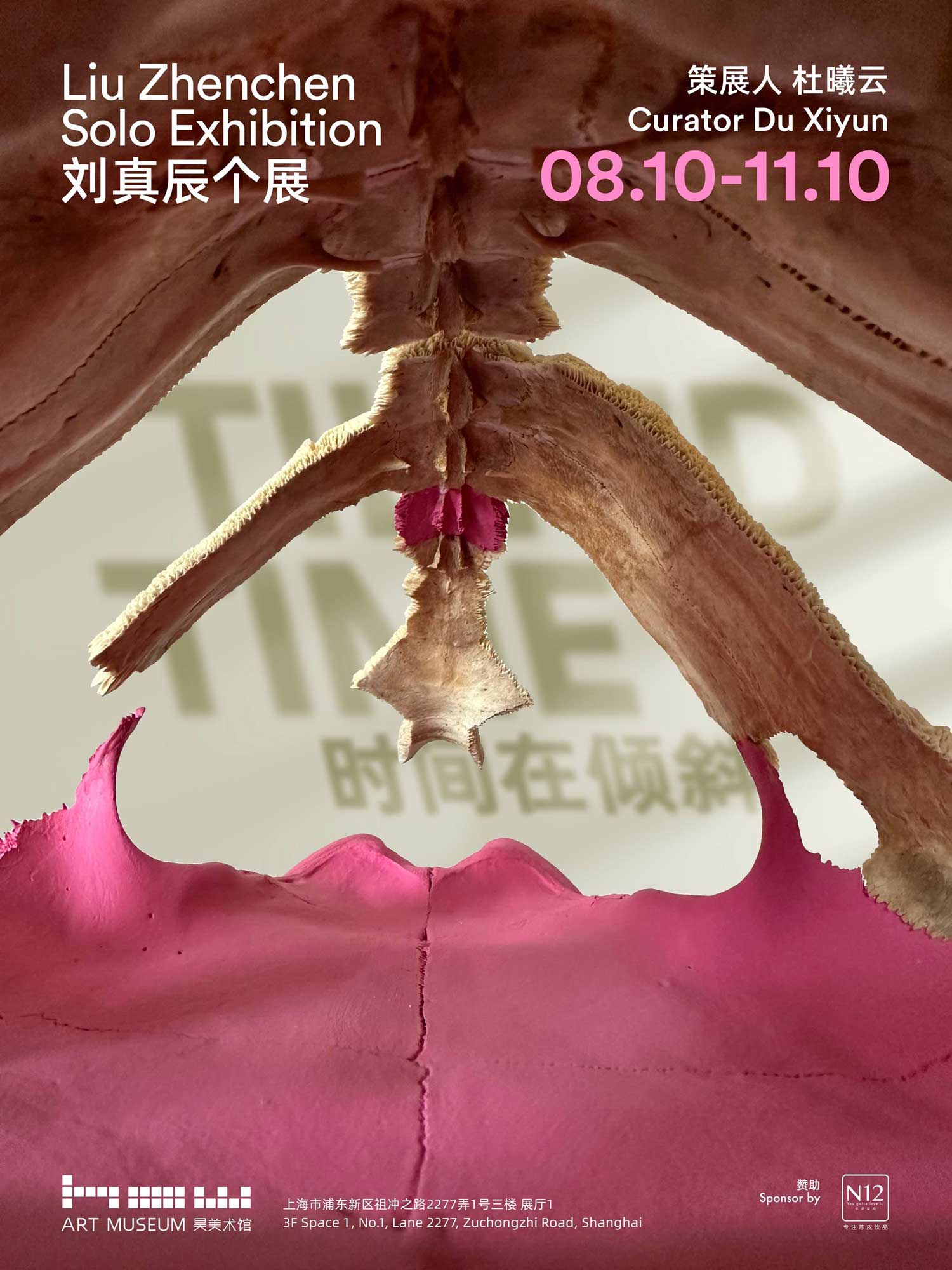展期 Period:
2024.8.10—2024.11.10
艺术家 Artist:
策展人 Curator:
支持 Support:
M艺术空间 M Art Center
地点 Venue:
前言 Preface:
时间比空间更奇妙有力,无形无声却昼夜不息。万古长空,一朝风月,恍然不觉间,沧海桑田,物是人非。
以科技和消费主义为主要推动力的时代,多少人被卷入疾速漩涡中,不适却欲罢不能?光怪陆离、云诡波谲的景观里,到底有没有真相?巨量包抄、莫衷一是的信息中,生命的出口在哪里?……刘真辰在可感知的各种空间中理解着时间,用视觉表达回应他所遭遇的世界。
用电脑算法生成的《万花筒》系列,拾取荒谬的碎屑,重组为虚拟世界里的浮华幻像,绚烂辐射、无界蔓延——这是他有意地变本加厉。用铜版机直接拓印植物的《Panacea》(灵丹妙药)系列,把真实的根茎花叶封存到作品中,顺应时令节气、植物形态、药理特性来生长出作品的形式语言,在亲近大自然的过程中疗愈身心——这是他无意中回归质朴。
《冰碑》是冰块在融化、蒸发过程中展示气候变化的力量,各国国旗的颜色在地面上交融出一滩滩难以预料的画面,演习人类透支自然资源的后果,命运之手在时光流逝中象征性显形。蜡经火后溅落、冷却、凝固,数以百万计的蜡滴,以各不相同的形态,簇拥堆叠出时光中难以计数的复杂变量。
影像《别了》中,邮轮上的人们向岸边的人们挥手送别,缓慢的播放速度让日常难以察觉的“视觉潜意识”浮现出来,船上的人们和此岸渐行渐远,终至消逝,道别成为永别。双频影像《行走》中,左侧是刘真辰耗时8小时在上海走街串巷,右侧是他的幼子姗姗学步。他幼时生活的社区弄堂,在都市变迁中经历了巨大变化;幼子第一次独立行走,世界充满新的未知。
《行走》中,步行8小时后的刘真辰把带在身上的一只乌龟放在了外滩,它以龟速走出了镜头的视野,不知所终。2024年的新作《Avant l'orage》(暴风雨前)中,艺术家将一只龟壳披上了当下国际流行的艳粉色外衣。面对未卜的前途,古人用龟壳占卜吉凶;在大数据、人工智能方兴未艾的当下,我们的前途也依然未卜,世界的复杂奥秘,是数据/算法永远无法穷究的。
在一个信仰科技、依赖数据的时代,专项研究的结论却往往并无新意:有一些非常简单的事情能让人们感到快乐,它们已经存在了几千几万年。但人性和时代的吊诡之处是:实际生活中,人们往往没有做这些明显会让人快乐的事情,反而正陷入大数据显示不太可能让人快乐的事情中……《Après l'orage》(暴雨过后)的原材料,是刘真辰在丹麦海滩上找琥珀时捡到的一根木化石,历经千万年的地壳运动后,它被艺术家拾取并涂以粉色,放置到艺术语境中,用远古的现在,来叩问现在的未来。
不适的心灵寻找到抚慰后,会从中汲取能量反哺令人不适的处境。当刘真辰把《Panacea》(灵丹妙药)投放到电脑算法里,出现了《Meta Panacea》。它们是人性和程序的共舞,固守和开放、不变和激变、质朴和绮丽间的张力,让艺术家经历了不适和舒适、辨别着表象和真相的感悟荡漾出更复杂的涟漪。缤纷流变的《万花筒》中的视觉元素,曾经取自各种文化症候,如今替换为花草枝叶等“灵丹妙药”,反讽的基调减弱,涌动出幸福感来。社会现场中的装置《冰碑》转化为画面上的《冰碑》时,平添了愉悦的趣味和轻快的气……
有意无意间,天真敏感的艺术家可能充当着异在者和先觉者的角色。刘真辰在空间中对时间的理解,用视觉表达对人生经历的回应,和里尔克的有些描述接近:在诗篇《时间之书》中,诗人写下如此字句:“时间倾斜触碰我,发出清澈、金属性的声响。我的感知在颤抖。我感受着我的能力——然后我抓紧了那可形塑的一天。”
Time is more wonderful and powerful than space, invisible and silent but never stopping day and night. The sky stretches for eternity, and once the wind and moon blow, suddenly and imperceptibly, the sea and the earth change, and things change.
In an era driven mainly by technology and consumerism, how many people find themselves swept into a rapid vortex, uneasy yet unable to stop? Is there any truth in the bizarre and unpredictable landscape? Where can we find the exit in life amidst the overwhelming amount of information that is both encompassing and confounding? Liu Zhenchen comprehends time in a variety of tangible spaces, using visual expressions to respond to the world he encounters.
The Kaleidoscope series, generated with computer algorithms, gathers fragments of absurdity and reassembles them into dazzling virtual illusions, brilliantly radiating and spreading without boundaries - a deliberate exaggeration. The Panacea series, using direct copperplate impressions of plants, preserves the real roots, stems, flowers, and leaves in the artworks. The works' formal language grows in accordance with seasonal rhythms, botanical forms, and medicinal properties, healing the body and mind in the process of being close to nature, marking the artist’s unintentional return to simplicity.
Ice Monument demonstrates the power of climate change through the process of ice melting and evaporating. The colors of various national flags mingle on the ground to create an unpredictable puddle of images, simulating the consequences of human exploitation of natural resources, symbolically manifesting the hand of destiny in the passage of time. Wax, after being melted, cooled, and solidified, forms millions of unique droplets, clustering together to resemble the inexhaustible variables of time.
In the video The Farewell, people on a cruise ship wave goodbye to those on the shore, the slow playback speed revealing a "visual subconscious" that is hard to notice in daily life. As the people on the ship drift apart from those on the shore, eventually fading away, the goodbyes solidify into a permanent farewell. The dual-channel video The Walk Liu spending eight hours walking through the streets of Shanghai on the left screen, while his young child toddles on the right. The neighborhood alley where he lived as a child has undergone great changes with urban development; his son's first independent steps echoes a world of new unknowns.
In The Walk, Liu Zhenchen releases a turtle he carried onto the Bund after an eight-hour walk, letting it slowly walk out of the frame, its fate unknown. In his new 2024 work Avant l'orage (Before the Storm), the artist coats the turtle's shell in bright pink, a color currently trending worldwide. In the face of an uncertain future, the ancients used turtle shells to divine good and bad luck. In today's era of big data and artificial intelligence, our future remains uncertain, as data and algorithms often prove unable to explicate the world’s mysteries.
In an era dominated by faith in technology and reliance on data, the findings of specialized research often reveal no new insights: there are certain profoundly simple things that have the power to bring joy, and they have persisted for thousands or even tens of thousands of years. However, a curious paradox of human nature and our times is that in actual practice, people frequently neglect these evident sources of happiness, instead becoming entangled in activities that big data suggests are unlikely to bring true joy... The materials for Après l'orage (After the Storm) include a piece of fossilized wood that Liu found on a Danish beach while searching for amber. After millions of years of geological movement, the artist picked it up, painted it pink, and placed it in an artistic context. Using the ancient present, he questions the future of the present.
After finding solace, the discomfort-stricken soul draws energy to feed back into the discomfort. When Liu Zhenchen input Panacea into computer algorithms, Meta Panacea emerged. These are a dance between human nature and programming, a tension between onservatism and openness, stability and change, and simplicity and elegance, enaabling artists to experience both discomfort and comfort, discern between appearance and truth, and unleash more complex ripples. The visual elements in the Kaleidoscope, once derived from various cultural phenomena, are now replaced with Panacea like flowers, branches, and leaves, diminishing the ironic tone and ushering in a surge of happiness. When the social installation Ice Monument is transformed into the visual Ice Monument, it adds a joyful and lively atmosphere.
Intentionally or unintentionally, an artist's innocence and sensitivity may cast them in the role of the outsider and prophet. Liu's understanding of time in space, and his visual responses to life experiences resemble some of Rilke's descriptions. In the poem The Book of Time, the poet writes the following: "Time touches me at a slant, emitting a clear, metallic sound. My perception trembles. I feel my abilities—and then I seize the moldable day."

